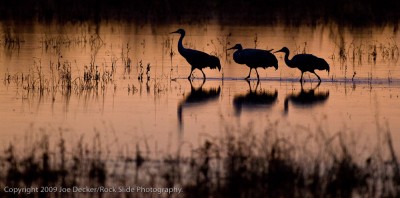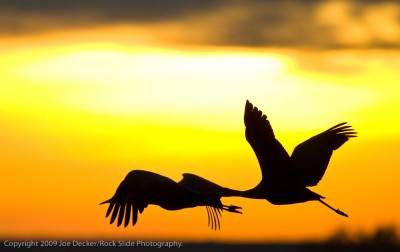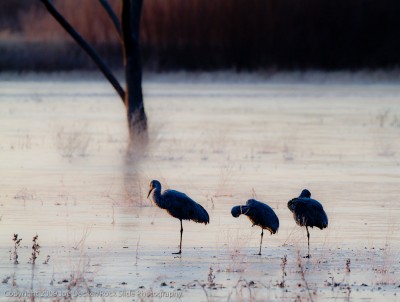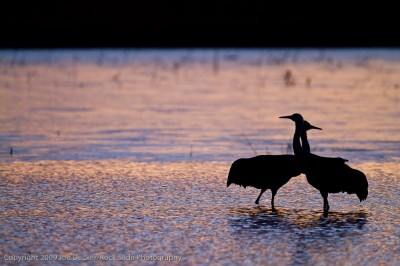
If you like this article, you can now get the book! Joe has expanded the “Tuesday Composition” series into an inspiring new ebook on composition, especially for nature photography. Check it out: The Tuesday Composition.
For the past week and a half, I’ve been shooting in New Mexico; and for the last few days I’ve been doing a lot of work at Bosque del Apache National Wildlife Reserve. Sunrises and sunsets are magical there, and often end up involving silhouettes, which got me thinking again about composing with silhouettes. I’ve touched on the subject of shadows and silhouettes before. But today I’ll go into more depth on the subject.
Silhouettes abstract objects into a two-dimensional shape, eliminating their color and texture. That’s a powerful tool for those moments where the shape of an object can communicate your intent effectively. But with that power comes a danger of accidentally removing some information you really need for the image to make sense.

Merging–where two objects (or two parts of the same object) meld into one because you can no longer tell which parts of the dark area come from one object and which come from another–is a consistent danger when making silhouettes. In most cases, you’ll need to keep the objects in your photograph completely separated and unmerged if you want the viewer to be able to make sense of the image.
For example, in Crane Family Stroll, I worked not only to keep the three Sandhill Cranes apart, but I also selected moments when their shadows didn’t greatly merge into the silhouettes of the grasses. The crane silhouettes do merge a little bit with the reflections of the silhouette in the pond, but the symmetry, combined with the tiny contact area between the silhouette and it’s reflection, keep the image easy to comprehend. Sunset Merge doesn’t work so well for me because the merge between two Sandhill Cranes make it a lot more difficult to figure out what’s going on.
Of course, “easy to comprehend” isn’t always an absolute goal. Sometimes it’s fun to try and play with merging silhouettes, as I did in Love Birds. That image intentionally merges the silhouettes of the two birds, metaphorically seeing “two birds as one”. Still, even though I think the primary merge worked in this image, the legs of the crane on the right also merge, and I would have preferred that they hadn’t. One unfortunate challenge of photographing wildlife is that animals usually aren’t quite as cooperative as human models.

For both human and animal models, the pose and the direction from which you view the subject is critically important. If you want to communicate expression, or the direction the subject is looking, you’ll need the face to show in the silhouette. The model will have to be facing left or right.
Three Cold Cranes (while not providing pure silhouettes) provides a great illustration. Of the three cranes in the image, only the leftmost “reads easily” in terms of identifying it as a crane, providing a sense of direction, and a sense of expression. The middle one gives some sense of direction with it’s leaning head, but doesn’t manage to convey any sort of expression. And the right one is hard to make sense of at all, or would be if the birds had been completely silhouetted.
Silhouettes are wonderful. The limitation that we face as photographers–that our prints can’t convey the enormous range of brightnesses that our eyes can see in the real world–becomes a powerful tool for image abstraction. But because photographs see so much differently than our eyes, it’s easy for two objects that seem quite separate to the photographer at the time merge when the photograph is made, to the detriment of the image.

Lars Clausen
8 Dec 2009Good advice! I like the Love Birds particularly because the eye can be tricked into thinking the neck are actually twined around each other, even though I guess they’re just one in front of the other.
Joe Decker
9 Dec 2009Lars: Yeah, although I had to go back and look (and muck with the conversion settings) to be sure, but yeah, one is in front of the other. They were definitely interacting through the sequence of a few dozen shots I got at that moment, still not sure I picked the one that’ll eventually be my favorite, but either way, it did make for a useful example 🙂